Kansas Speedway: Drive it into the corners until you see Elvis
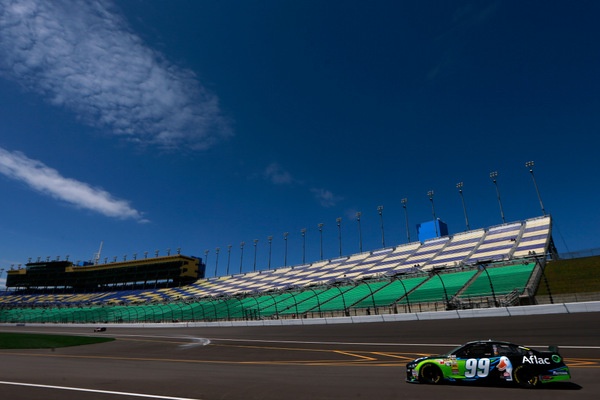
Blue skies in Kansas City....but cold, like Rockingham-cold. Where are the smudge pots? (Photo: Getty Images for NASCAR)
(Updated)
By Mike Mulhern
mikemulhern.net
KANSAS CITY
Tony Stewart last fall called this track "stupid fast," with its new asphalt.
Jimmie Johnson described getting into these corners as "Drive it in till you see Elvis."
And Kyle Busch, with a nervous laugh, cracked "We're all high-fiving each other after qualifying because we're glad we got back here alive."
Fast-forward to here and now....where Friday afternoon four men practiced at speeds faster than Kasey Kahne's track record of last fall.
Fast.
"It's very fast....everyone is talking about how fast it is," Carl Edwards says. "We are going really, really fast."
Last fall corner-entry speeds were 204 mph. Friday here Edwards was clocked at 209 mph into the first turn.
That is breath-taking.
Toyota's Matt Kenseth, not renowned for qualifying runs over his career, surprised everyone by winning the pole Friday for Sunday's Kansas 400.
"The whole field has to feel bad, getting beaten by Matt Kenseth in qualifying," Edwards, second-fastest, joked.
To make the point even sharper, Kenseth won at this track last fall. "This is probably the fastest track we go to all year, and I wasn't really thinking about winning the pole," Kenseth said.
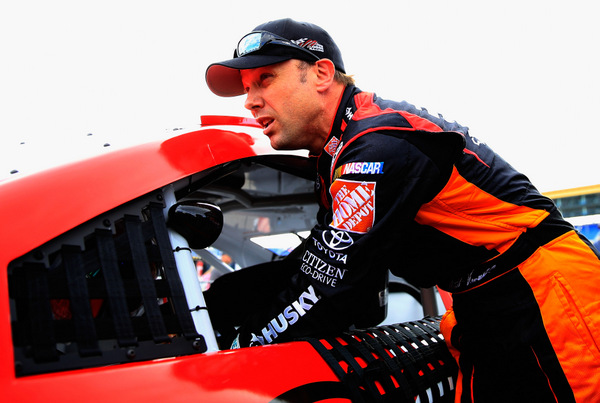
Matt Kenseth on the pole? Talk about surprises.... (Photo: Getty Images for NASCAR)
Kenseth's career qualifying average is only 19th, and this was only his ninth pole since joining the tour 14 years ago. This season his qualifying average has improved markedly, to about 10.8.
"Our cars just have a lot of speed," Kenseth said.
The top four qualifiers -- Kenseth, Edwards, Ricky Stenhouse Jr. and Sam Hornish Jr. -- all broke the track record that Kasey Kahne set only last fall. Kenseth's run was at 191.864.
Of course it's not the going-fast that's an issue. It's rather the stopping-fast. Ask Aric Almirola, who crashed while leading last fall. Ask Jeff Gordon, who was forced to a backup this weekend after crashing in qualifying; he will have to start last.
Kyle Busch, the Texas NRA 400 winner, also was forced to a backup after slapping the wall. But he qualified his backup well, on the third row.
"There were a lot of people blowing right fronts last fall, trying to get grip," Kenseth pointed out. "But I don't think tire wear will be an issue."
Certainly this track surface, with much fresher asphalt, is quite different than the well-worn asphalt at Texas Motor Speedway. Worn asphalt creates tire wear, which everyone likes. Here, however, there is little tire wear, as smooth as the surface is, and the issue is instead potentially excessive tire heat or teams abusing chassis setups in trying to get the cars to turn better in the corners.
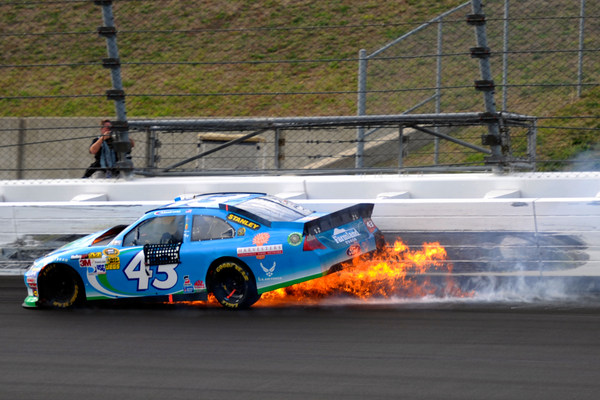
Aric Almirola was fast here last fall, but was his chassis setup too aggressive? (Photo: Getty Images for NASCAR)
One of the big stories this weekend is the same question heard last week at Texas: Okay, now what's up with those Fords?
A week ago, heading into Texas 500 weekend, Ford teams appeared well off the pace set by Toyota and Chevy teams over the opening weeks of the season with these new 2013s.
Ford drivers seemed down on speed, some teams were grumbling about just that.
And as that 500 went on, with Toyota's Kyle Busch and Martin Truex Jr. dominating, the storyline appeared continuing.
Suddenly down the stretch, here come the Fords, like Texas Rangers fast on the hunt.
And here Friday afternoon Ford men Edwards, Stenhouse, Hornish, Almirola, Greg Biffle and Marcos Ambrose were among the fastest. Fords took four of the top six spots in qualifying, and Stenhouse indicated improvements under the hood have been key. The slowest Ford drivers were Brad Keselowski and teammate Joey Logano, who face the loss of their crew chiefs for the Texas infractions.
The storyline of speed, ironically, has turned to what's wrong with the Chevys.
Chevy teams faded late at Texas; Jimmie Johnson apparently did not lead a single lap (that appears in some dispute however). And here Friday Chevy drivers were noticeably off the pace, though none seemed concerned.
Of course this track is notorious for gas mileage finishes, rather than slam-bang battles to the flag.
The Ford question?
Ford team owner Jack Roush, while munching on birthday cake in Edwards' hauler during a mid-afternoon break, conceded Ford teams got off to a slow start this year.
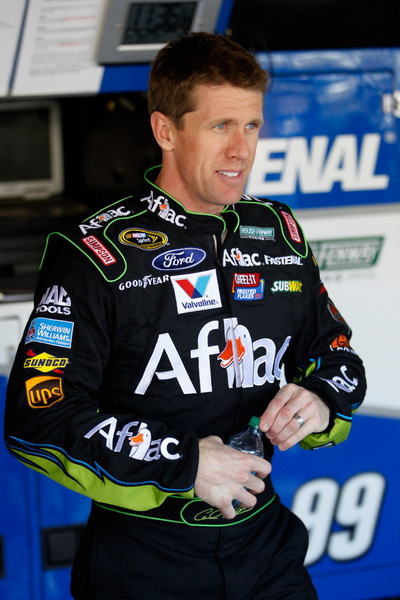
Carl Edwards: 209 mph into the first turn! (Photo: Getty Images for NASCAR)
What's the difference?
According to one rival, it may have to do with RPM. With the sleeker 2013s, RPM are up, and NASCAR has compensated in some of its rear end gearing rules.
At Texas, for example, RPM were down early in the race, but picked up as the weather cooled.
Does Ford now have a new top-end engine valve-train setup, designed for more RPM? That's what some rivals suspect. And Stenhouse pointed to work done lately by ace engine builder Doug Yates as remedying complaints by drivers.
Engine men are scratching their heads over engine RPM this season. At Bristol, for example, teams were turning 10,100; at Texas, on the other hand, they were turning only maybe 8500.
Roush himself said he was "embarrassed" by the relatively weak runs by Ford teams. But he quickly pointed out "a Ford is third in points (Greg Biffle) and a Ford is fifth (Edwards).
"When you have a jump ball, does the ball always go up straight....and is everyone's timing just right? No.
"As we've looked at the run we had with the car-of-tomorrow (2007-2012), we said we look forward to this change, because it gives us an opportunity to get a leg up on everybody.
"For Daytona we probably missed a couple of things, aerodynamically, and in the different configurations of the car under-body. We think we've got that understood and on our way to correcting that.
"At Las Vegas we weren't quite as good as we thought we'd be. We weren't terrible, but we weren't as dominant as we had been at 1-1/2-mile tracks.
"Carl won Phoenix, with some new pieces we'd worked up over the winter, that we thought would be useful. And Carl is good at Phoenix, so the jury is still on that.
"We just didn't jump off this year quite as fast as the Toyota bunch has or as the Hendrick (Chevy) guys have.
"But based on the way we tested here (a few weeks ago), and based on the way we tested at Daytona (earlier this week), we're going to catch up on the second bounce.
"I haven't had any personnel changes, I haven't had an attitude change, I haven't had a shortage of sponsorship, and we haven't limited our testing.
"The only thing that's different is that for the near-term the start of this season we didn't get as much for our efforts performance-wise as we have in the past. I've been extraordinarily frustrated and embarrassed that we didn't run better. And we are focused on that."
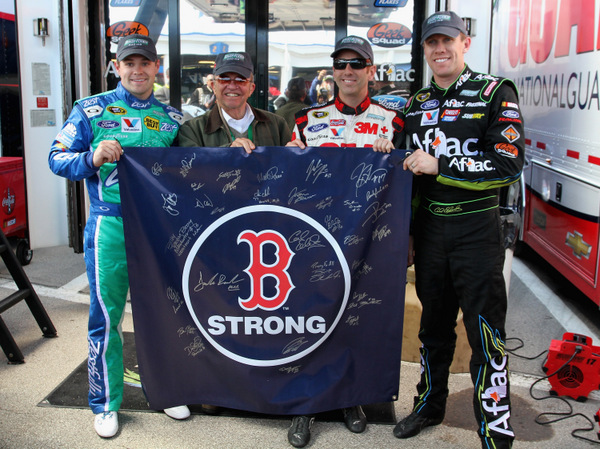
Jack Roush, with his drivers, and close ties to Boston (Photo: Getty Images for NASCAR)
OBTW, what about the latest rear-end chassis/gear controversy, this one involving new Ford teammate Roger Penske and his two teams. Last season Roush spent a lot of money and effort chasing the skewed rear-end designs the Hendrick Chevy guys came up with.
The 2012 Hendrick rear-end trick -- though NASCAR officials have stopped laying out any confiscated or controversial parts for public inspection -- was apparently a legal part that was being used for a purpose for which it was not intended. If that makes any sense.....
So when Roush asked last summer if NASCAR were going to ban that part, because it wasn't being used in the 'spirit' of the rules, NASCAR officials said no. And Roush and others had to spend a lot of money chasing that design.
At the end of the season, however, NASCAR decided to make that design illegal this year.
Just what the Penske engineers came up with isn't clear -- NASCAR again is refusing to lay out the parts in question.
NASCAR's original description of the part is that it wasn't in the 'spirit' of the rules. In assessing the brutal penalties NASCAR added that the part had not been submitted for approval.
Roush's take?
"We spent a lot of money chasing after that (Hendrick trick rear-end)," Roush says. "Then NASCAR made it real clear they were going to put a stop to that, with a mono-ball, and with no tolerance for people who would try to get around the rules.
"My guess is they (Penske) found something they thought would be okay, but NASCAR didn't like it.
"But I haven't seen the part either, so I can't comment on it specifically."
Would Roush like to see it? "Oh, no, that's a $100,000 part and 25-point penalty," he replied with a laugh. "Keep me away from that."
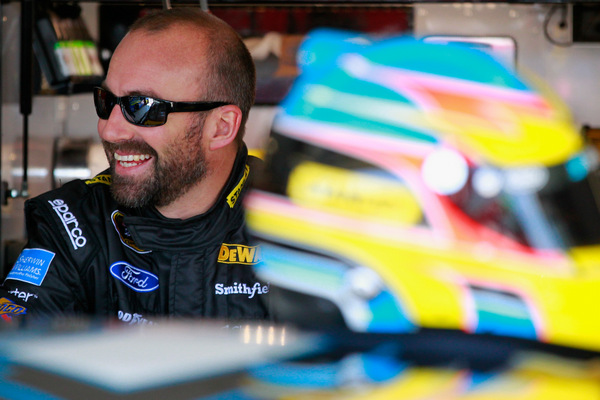
Marcos Ambrose, sporting a new look (Photo: Getty Images for NASCAR)
© 2010-2011 www.mikemulhern.net All rights reserved.
Web site by www.webdesigncarolinas.com







Post new comment